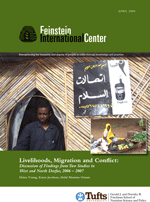This briefing paper discusses findings from a study conducted in Darfur from 2006-8 that explored the changing role of migration and remittances in the livelihoods of conflict-affected people.
We conducted two case studies using surveys and qualitative research. The first was of the five IDP camps outside the town of Zalingei (West Darfur), and the second was of both IDPs and residents in the town of Kebkabiya in North Darfur. The paper highlights the livelihood changes and adaptations internally displaced people (IDPs) and their hosts have made in response to the conflict in 2003 and consequent displacement. We found that in Darfur, as in other conflict zones, livelihood systems are in transition. IDP strategies are evolving in response both to blocked previous livelihood strategies, and to new opportunities presented by urbanization and the distorting effects of the presence of the international community. We found that remittance flows have increased slightly since pre-2003, but are available only to a small proportion of the population. Remittance mechanisms have shifted to adapt to insecurity.
Our findings have implications for three commonly asked questions:
• If and when will IDPs return back to their rural homes?
• How can a wider range of livelihood strategies be supported?
• Should remittances be supported and in what ways?
We think it unlikely that IDPs will return to their rural home areas and previous livelihoods, and more likely that IDPs will continue to foster their increasingly urbanized ‘multi-nodal’ and transnational livelihoods. This has implications for the policy environment. We argue that innovative approaches to support livelihoods are badly needed, but it is important to monitor and evaluate their impact on different groups, the local economy and environment. In particular the implications of harmful livelihood adaptations need to be recognized and addressed – ‘mal-adaptive’ livelihood strategies might provide food and income in the short-term, but they often incur longer-term costs for the household, and can increase societal inequities and marginalization as well as over-exploiting limited natural resources.
This briefing paper describes the background to the study, our methods, key findings and study implications.







